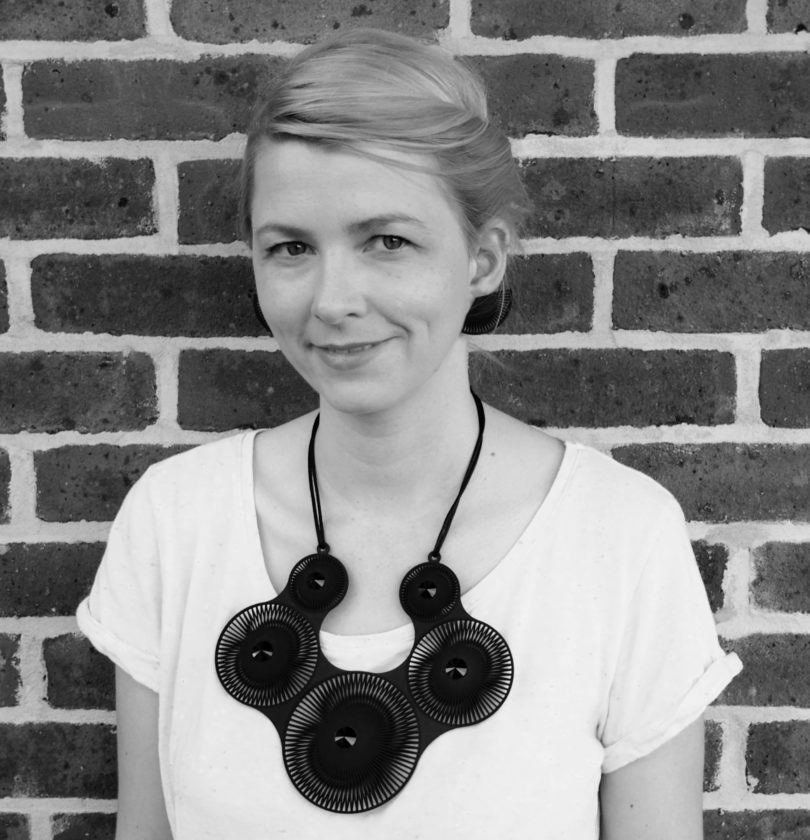
“Serendipity and the happy accident have often provided the start of something good, so you’ve just got to keep designing and making.” – Lynne MacLachlan
Lynne MacLachlan makes astonishing, bright pieces of 3D printed jewelry. Though she relies on Shapeways for prototyping and production, Lynne does not maintain a Shapeways shop since she finishes and packages her work at her studio in Glasgow. She sells her jewelry in boutiques and online.
Here, Lynne talks about her journey from aerospace engineering to shape grammar, and how low-cost 3D printing has liberated her design sensibility.
There aren’t a lot of fashion designers who study aerospace engineering. How did you get into aerospace? Why did you move away from it?
I think I was drawn to engineering as it seemed like a way of producing things and a secure profession, but I felt so detached from the actual things that I made. I made the the leap toward design as I wanted to be closer to the things I produced and be more hands-on.
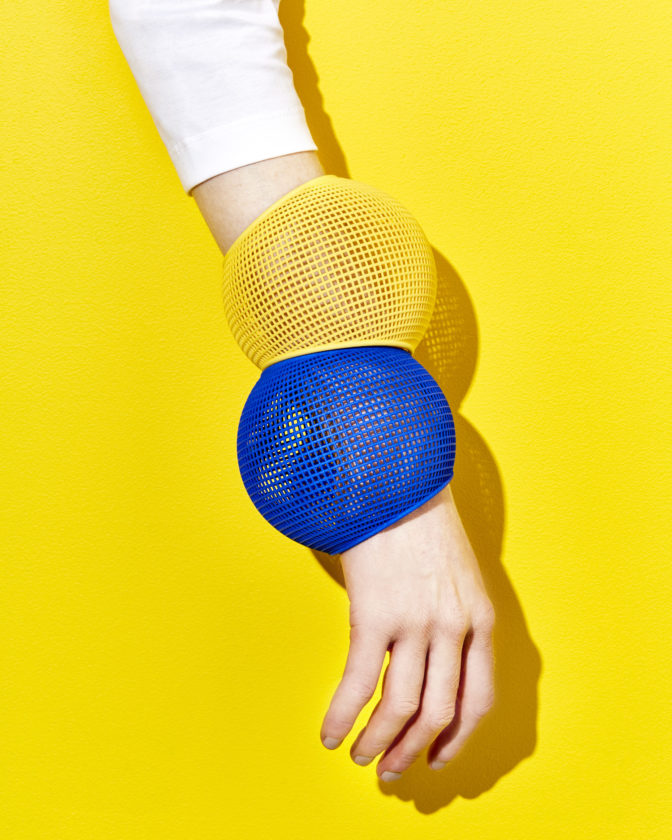
MacLachlan’s Gego Bangles (photo: Mathew Town)
The first 3D printed jewelry on your website was inspired by soap bubbles. Where else do you find inspiration for your designs?
Little bits of inspiration come from so many different places. You kind of triangulate yourself into your own design space by soaking up as much as possible and blending it into your personal language (to mix a few metaphors!). A healthy curiosity about everything from math and science to art, design, and tech, and I also collect endless images on Pinterest and Instagram and try and read widely.
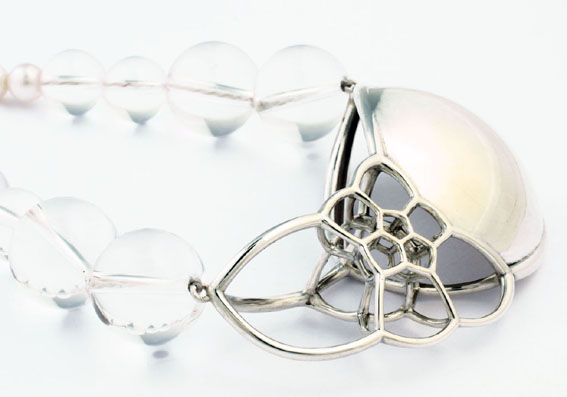
A necklace from the Bubble collection
It was really going to the Royal College of Art and living in London that opened up my world, but with the internet at our fingertips it’s not hard to do anywhere. More specifically, I am just constantly looking while I experiment with my tools and materials. Serendipity and the happy accident have often provided the start of something good, so you’ve just got to keep designing and making.
Talk us through your design process. How does Shapeways fit into your workflow?
My workflow is very tools- and process-based, although I spend a lot of time daydreaming about shapes and patterns! I use different software tools and create my own and then experiment with these until I find something that grabs me. It’ll then be honed into a printable design. Then, once I have things printed back from Shapeways, I’ll do more honing, testing colors, checking sizes and fits for the body, and even cutting bits off to inform the way it needs to be improved.
“When I discovered that Shapeways was producing reasonably priced 3D prints, I was suddenly able to take more risks that I previously couldn’t afford to take.”
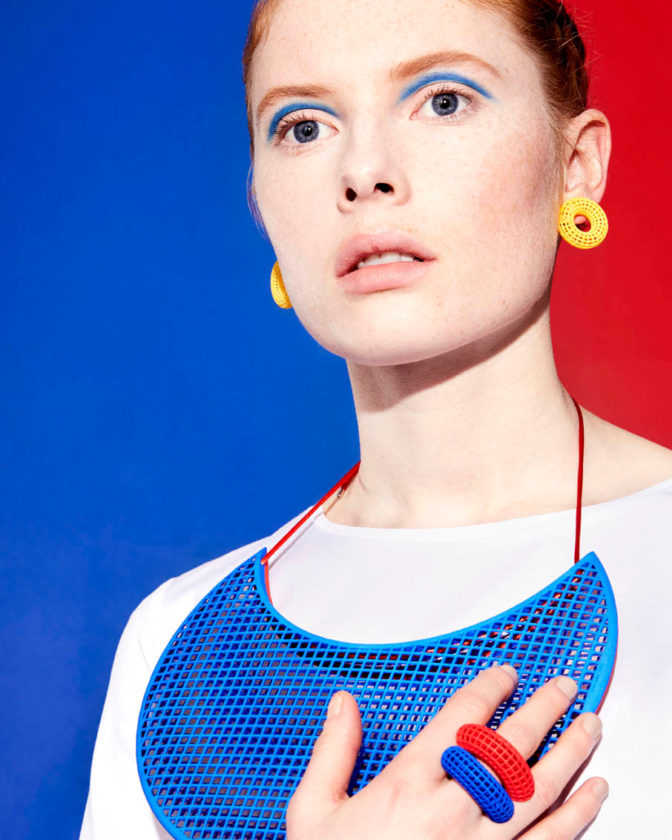
MacLachlan’s Mesh necklace and earrings from her Phase jewelry collection (photo: Mathew Town)
When I discovered that Shapeways was producing reasonably priced 3D prints, I was suddenly able to take more risks that I previously couldn’t afford to take. Every design needs at least two prototypes to get right, and a coherent collection has countless prototypes and potential designs. It’s so great to get the CAD designs materialized so easily and quickly. It means I can concentrate on making tangible pieces with the visual delight I aim for.
What 3D modeling tools do you rely on, and how do those tools shape the things you make?
I mostly use Rhino and its algorithmic plugin, Grasshopper. I am so familiar with these now I can work in an uninhibited way and also create my own personalized Grasshopper tools.
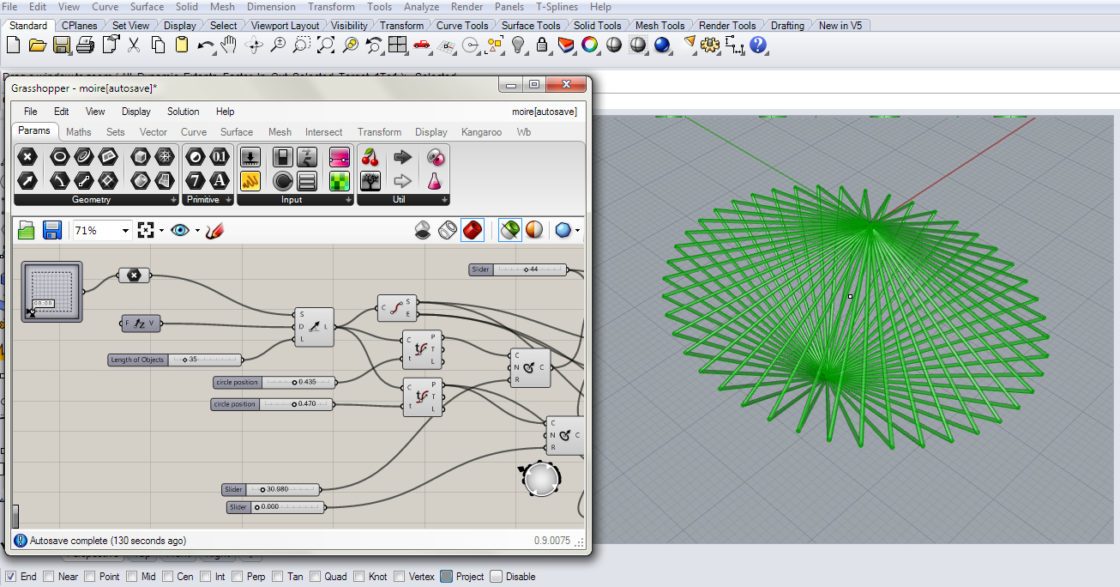
One of Lynne’s experiments with personalized generative digital tools
But I also like to bring in other software. For instance, the geometry for the Bubble collection came from a mathematical visualization tool called Jenn, which I then refined into jewelry pieces.
One of the keys to creativity can be harnessing tools from different arenas in new ways, so I like to keep my eye open for other interesting applications I can bring in to refresh things.
You rely on Shapeways for production, but you don’t sell through a Shapeways shop. What do you do with your pieces after they come back from Shapeways?
My pieces come to my studio in Glasgow for a final check, hand finishing fittings and parts, some dyeing, and to be combined with my own information cards and bespoke packaging before going to customers and stockists. This allows me to really elevate the designs. For instance, I like to have metal earring fittings cleverly integrated and for pendants to hang on high-quality cords and chains. Some bigger statement pieces may have two to four different parts to be fitted together.
I also like to experiment with different dyes and colors. This aspect of my work is the one I enjoy the most. At the moment I am dip-dyeing some new pieces, which needs to be done carefully by hand but gives beautiful ombré effects that are very gratifying.
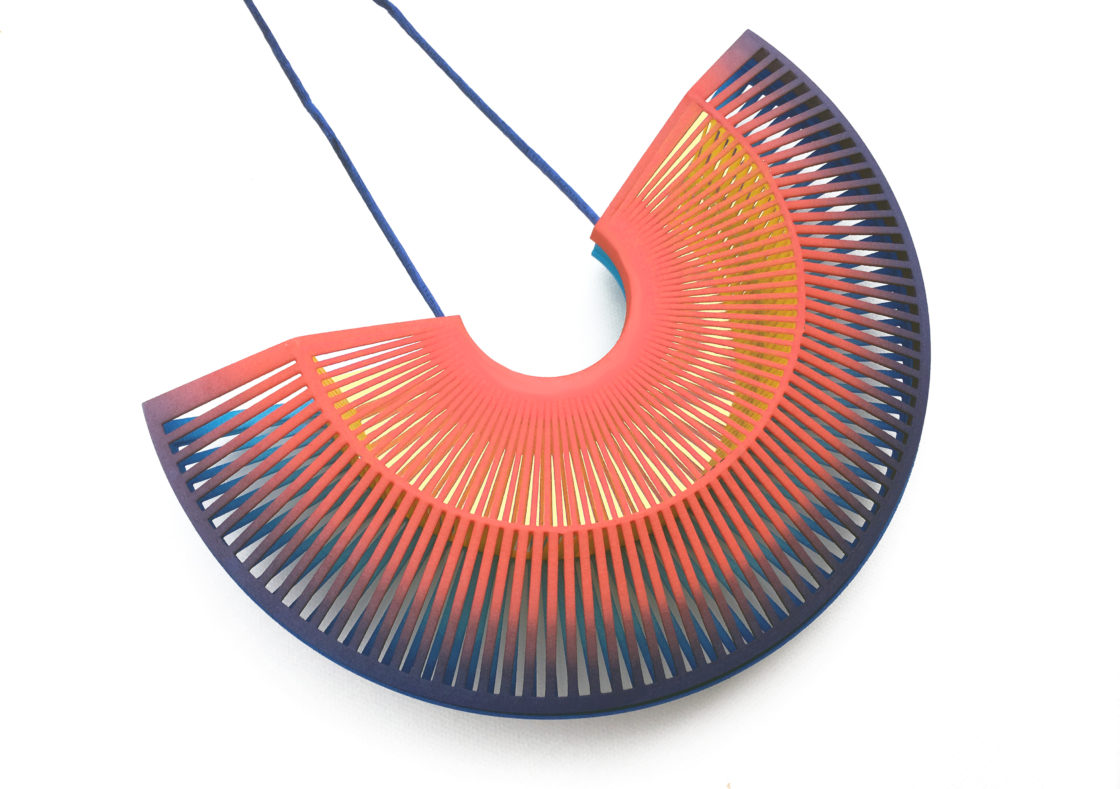
The ombré dyeing effect on MacLachlan’s Statement Necklace
Do you have a muse? Who do you imagine as the audience for your jewelry?
I don’t have a muse as such, maybe myself, embarrassingly. I try and make things that I would like to wear. My aim for my designs is that they are reasonably accessible to people who like them while maintaining a considered and conscientious level of design and production. My audience is mostly women (although I’m delighted to have some male clients and would love to have more) who are of course design- and fashion-conscious. And it’s a surprising array of ages, which I am also pleased about.
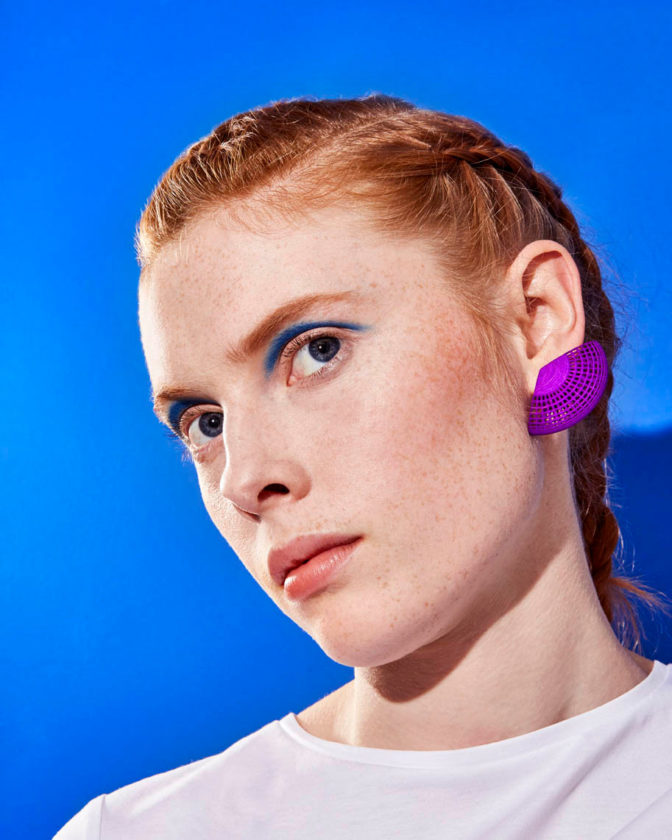
Helio Earrings (photo: Mathew Town)
How much do customers care about the process, or are they just into the finished product?
I think it varies from person to person. Some people are fascinated by the processes, usually people who make themselves. Others are just drawn to the colors, shapes, and optical effects of my work. When I started using Strong and Flexible Plastic it was a joy to work with, but I wasn’t sure how people would respond to it, if they would “trust” this new material, but I was pleasantly surprised at how open people are to it and how much they love it.
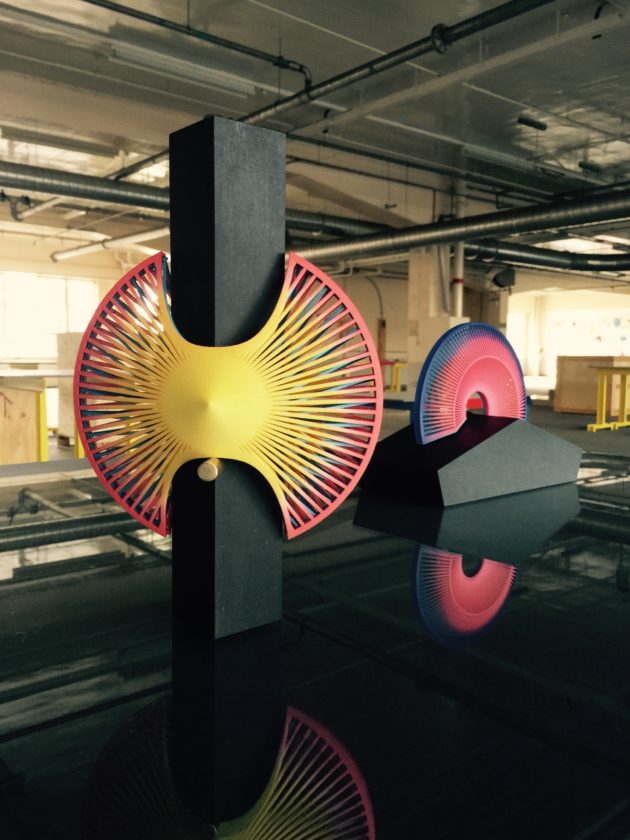
MacLachlan’s work on display at the Dundee Design Festival
I think 3D printing is in a good place in the public consciousness now. They have heard of it and “get it,” but it’s still exciting and interesting. I think there is a bit of kudos in being able to tell your friends your lovely earrings were 3D printed.
You’ve been making jewelry for several years now. What have you learned over that time? How has the technology evolved over that time?
I’ve been doing my current style of work for about four years. Before this in my studies I was always drawn to experimenting with digital technology, first laser-cutting and then on to 3D printing. The biggest change for me has been the availability and affordability, which I found through Shapeways. During my masters, I was using wax 3D printing and casting and also investigating some plastic printing in my university, but the cost was so expensive it definitely subdued my creative experimentation, as I just couldn’t afford to take the risks needed to really evolve great designs.
I personally have learned a lot about what is possible with the my tools and materials just by using them so intensively. I can better judge the success of a design on many levels now, hopefully increasing the quality of my designs.
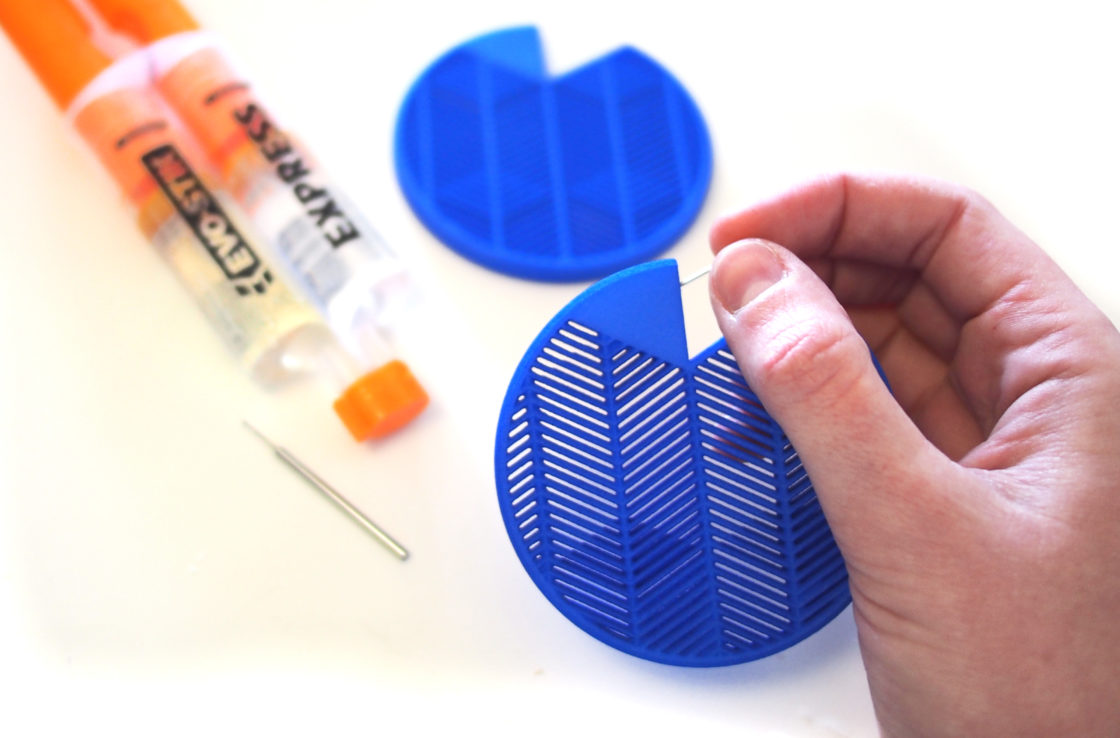
Lynne in the process of creating her Shimmer earrings
You’re finishing up a Ph.D. in design. What are you focused on? How, if at all, does that research relate to your jewelry?
In my Ph.D. I investigated how designer-makers use analogue and digital tools to generate creative outcomes. I then categorized these with a visual, rules-based design theory called shape grammar. I also used shape grammar to investigate multi-material 3D printing, developing tools to handle variable properties in a design. It all gets a bit technical as Ph.D.s do, but overall it hopefully offers designer-makers some strategies to bring about creative episodes, whether they rely on hammers or multi-material 3D printers.
Doing the Ph.D. really helped me understand what I was trying to do in my design processes in quite a blind way. It’s helped me feel more efficient and confident about what I am doing and why. My experience in art school was that the creative process sometimes seemed like a bit of a black art. I wanted to counter this.
Sometimes you make videos of your designs. What’s hard to understand about your jewelry from a still photograph?
My pieces are foremost about visual delight and are designed to create moiré patterns as the wearer moves in relation to a viewer. Simple videos are a great way to communicate this to people. Suddenly they can see the pieces in their full glory.
Shimmer Movie from Lynne MacLachlan on Vimeo.
You can buy Lynne’s jewelry from the studio website or stores in England, Scotland, and Sweden. Follow her studio on Pinterest or Instagram.


